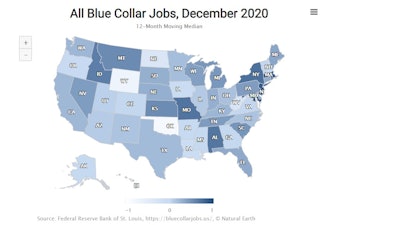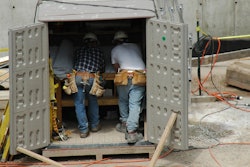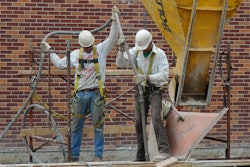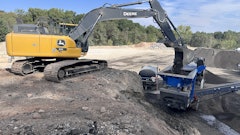
The blue collar jobs sector continues to be one of the few areas showing steady job improvement, with sustained growth in the fourth quarter 2020. But the latest Blue Collar Jobs Tracker analysis hints at declines ahead, pointing to January’s less than stellar national jobs data.
“Consistent job growth at the end of 2020 shows blue collar industries were finally, albeit slowly, rebounding from the beginning of the pandemic,” noted Matt Sedlar, data analyst, Center for Economic and Policy Research (CEPR). However, he added, “The January numbers that were released last week don’t paint a great picture.”
Blue Collar Jobs Tracker is a project of the Center for Economic and Policy Research (CEPR) created to take a closer look at the path of job growth in four major blue collar industries: manufacturing, mining, construction and logging. The latest report shows employment in these sectors increased by 76,000 jobs in December, or 0.38% over the previous month. The three-month average from October to December was 83,670 jobs, or a 0.42% month-to-month change.
Largely Sustained Though Modest Job Gains
Construction jobs increased by 42,000 in December, or 0.57% over the previous month. “The three-month average from October to December was 46,330 jobs, or a 0.64% month-to-month change. This reflects a strong October, with 73,000 jobs added, and a smaller increase in November of 24,000 jobs,” Sedlar pointed out.
By region, the West saw the most substantial increase, rising 1.92% over the previous month to 36,800 construction jobs and likely led by a 10.2% bump for the month in construction starts for new privately owned housing. California is now only 4,700 jobs below its February pre-pandemic peak. Arizona and Oregon did not share in the gains, however, declining by 4,100 (-2.35%) and 800 (-.74%) jobs, respectively.
 bluecollarjobs.us
bluecollarjobs.us
The Midwest and South saw construction job gains of 17,500 (+1.27%) and 10,600 (+0.37%). Illinois and Indiana led the Midwest with net increases of 8,300 (+3.85%) and 3,300 (+2.19%), while Michigan saw the biggest decline of 1,800 jobs (-1.02%).
In the South, Florida and Texas led construction job growth with net increases of 3,200 (+0.57%) and 3,100 (+0.41%). Louisiana saw the largest net decrease, with a loss of 2,000 jobs, or -1.51% over the previous month.
Manufacturing jobs rose just 0.25% in December, climbing by 31,000 jobs. Jobs added over the last three months have been consistent, Sedlar stated, with 32,000 added in October and 41,000 in November. By region, the South again had the largest gains, with 22,800 jobs added, or + 0.55% over the previous month.
Mining and logging jobs increased by 3,000 in December, or 0.50% over the previous month. For mining (minus support activities), the net increase was 1,300 jobs, and for logging, the net increase was 900 jobs.
Pandemic Influence Continues
While the Blue Collar Jobs Tracker indicates a slow rebound from pandemic lows, the lower than expected national job growth in January reflects the COVID-19’S ongoing influence. Sedlar believes the winter surge in coronavirus cases could further delay job recovery, including in the blue collar sector.
“The sooner everything is under control,” he stated, “the sooner we can see the blue collar jobs recovery resume.”
Information provided by the Center for Economic and Policy Research and edited by Becky Schultz.



















